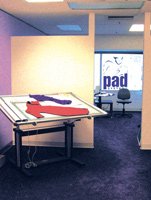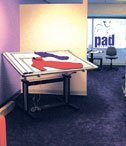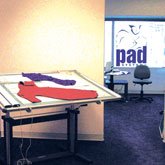PAD System Splits With GCL, Relocates L.A. Office
PAD System Technologies has a new home in the California Market Center after it split with GCL, the company that helped found PAD and was, until recently, its distributor for the Western Hemisphere.
Located in CMC suite B721, the new PAD office will be open and staffed every day under the direction of Kristine Gloviak, the company’s longtime sales and training manager.
“It’s been a relatively seamless transition,” she said. “We have about 12 free-lance trainers, two strong support people in North America and two salespeople.”
PAD was founded in 1988 in Montreal with assistance from Le Salle College. GCL is a distribution arm of the university. PAD was sold in 2007 to Hong Kong–based Modular Computer Corp. MCC had been PAD’s largest distributor for more than a decade and had good penetration among the Asian contracting community. “It’s Asia that made PAD a global superpower,” Gloviak said.
After the sale, MCC changed its name to PAD System Technologies. GCL continued to handle distribution for PAD in the Western Hemisphere—including Europe, North America and South America—for three and a half years until its contract expired.
Instead of renewing, PAD opted to take over global distribution, with offices in Asia, Montreal and Los Angeles.
PAD 5.0 set for January release
PAD’s new Los Angeles office opened in time for the mid-January launch of PAD 5.0, or PAD2, the latest version of the CAD/CAM software for pattern design and marking and grading.
Among the changes in 5.0 is the elimination of the security key. Instead of using a USB security key to gain access to the PAD software, users will get usernames and passwords that will allow them to begin using the software.
In addition, PAD users will be able to read raw Gerber and Lectra files without using DFX conversion files.
“File exchange is huge because we’re all so global,” Gloviak said.The other new development is the introduction of more-affordable versions of the software for young designers and students.
In addition to the Enterprise version of PAD 5.0, which is for industrial applications, PAD will be offering the Professional version for young designers and the Academic version for students. The Professional version will cost in the $1,000 range, and the Academic version will be priced below $300, according to Gloviak, who noted that the Professional and Academic versions will not include all the features available in the Enterprise version. For example, in the Academic version, there’s a 20 pattern-piece limit and limitations on sizing.
“We’re finally able to give students something to do their homework with,” Gloviak said.“They’re not just renting, they own it.”
Visitors to PAD’s website (www.padsystem.com) can go to the company’s demo page to find out what’s new with 5.0, including detailed information about the features in the Enterprise, Professional and Academic versions of the latest software.
Since the move, Gloviak has been conducting product demos—many of which are held virtually. “I’d say 60 percent of the demos I’ve done recently are on Go To Meeting,” she said. “This week, I had demos in Mexico, New York, Montana and Chicago.”
Gloviak has a bilingual assistant, Martha Zelaya, to help with the Spanish-speaking market.
Gloviak said the company will probably host a 5.0 launch for the West Coast market in the spring.
PAD can be reached at (213) 627-8770 or (855) PAD-4USA.—Alison A. Nieder

























